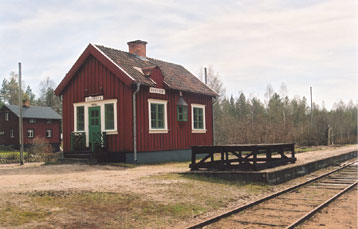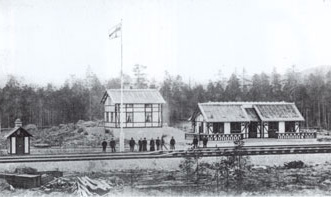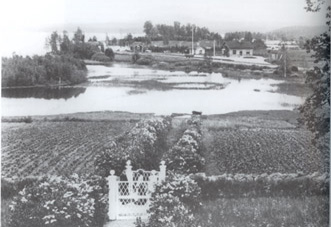
The modest stationbuilding in Göringen as seen today.
In the Background, the former living quarters for the staff. The house serves today as a holiday cottage.
Colorphotos by Ollie Ahokas,
black and whites from the book Göringnen - Dalfors by Föreningen Dala-Hälsinglands Järnväg
More pictures on Orsa Furudalen line
Historical background.

Göringen is located in very isolated site in woods, between two lakes in eastern Dalecarlia, in roughly middle of Sweden. The site also served as a junction to a short 3.2 kilometer branch to the Lake Amungen, where it terminated at Dalfors where a small yard was constructed with a depot untill 1960, when the line was abandoned and tracks were removed. This feature will also include a short piece on Dalfors.
In the turn of the century there was a plan to construct a railroad from Kristinania (Oslo, Norway) by Kongsvinger (Norway) towards Söderhamn in the swedish east coast. One of the reasons to construct this line was to efficent way to deliver forrestproducts to England, which had removed tolls for timber from Scandinavia in 1866, and to offer better communications for the people along the line and tighten the shaky union of Sweden and Norway. The union lasted to 1906, as Norway declared itself as an independed kingdom. After a number of studies during 1877 and 1890.es The plans were reduced to a line from Mora to Bollnäs or the coastal port of Söderhamn. In 1891 the connecting line between Mora and Kristinehamn was in service and this line was nationalized in the trun of the century as the southern most part of the inlandline to the northern ironore minefields at Gällivare near Kiruna.

An E10-class 4-8-0 pauses during the twilight of steam. E10-class were the last constructed mainline tender engines on SJ. Dating from 1947.
Photo from "De sista ångloken" by SJK
Finally, line was reduced into a line between Bollnäs and Orsa and opened for service in two sections, The line Bollnäs - Voxna was opened in 4.th of November 1899 and Voxna - Orsa in 18.th January in 1900. The opening ceremonies were held in 23. august 1902.
The service on the line was not exactly busy, and this was one of the reasons the company was in recevership in 1915. Two years later the board succeeded to lease the line to Swedish National Railway (SJ), which finally merged the line in 1927. The last passangertrain on the former DHJ ran in 1971 and the following year SJ ran their final freight. But the line was reopened as industrial spur in 1996 and upgraded in to a regional line in 2000. Today, thew western part of the track (Orsa-Furudal) is maintained by Inlandsbanan, and the eastern part by Banverket.
The branch line Göringen - Dalfors.

The station building and yard in Dalfors at the early years.
As early as in the first studies from 1870.s, there were plans to connect the Lake Amungnen to the railroad, also there were plans for an additional branch to the Lake Göringen, which was never carried out. The reasons for this was to haul timber. In Sweden and Scandianvia it was to common to transport logs by the streaming waterways to the terminales and sawmills.
During the planning stage, there were discussions for the location of the mainline station a nd the branch termial. In the beginning there it was only planned to use the branchline in seasonal service. But the poor state of the public roads made the line used in daily bases when the line was opened. The line was constructed with second hand rails from OFWJ and the line was ready for service in 1901.
At Dalfors the depot was located close to a sawmill, and preceded first through farming fields and meadows in to the woods on grade. The altitude in Göringen was 25 meters higher than in Dalfors, which caused some difficulties for the relatively light engines used on the line. Accidents were not not incommon....
In the early days the trains wer mixed, and the mainline trains served the branch. In 1906 there wer 2 daily runs to the juction, one morning train and one in afternoon. As the company was bancrupt in 1915 the service was reduced. The branch was served by two daily freights that picked up passangers. As the SJ took over, the service was improved by some of passanger runs were run on the branch.

A B-class 4-6-0 waits at Göringnen at a freight headed by a E2-class 2-8-0 to clear the main
Photo from "De sista ångloken" by SJK
In 1935 the light 2 axled railcars of Y-class provided cost efficent replacement for the steamruns on the line and the railcar Y-322 was stationed in Dalfors in 1942 and placed on the passanger runs on the branch to the junction in Göringen. When the railroad was in need of being serviced, it was ran to Bollnäs and replaced temporary by another railcar. In 1947 the service was increased in to 4 daily runs. In 1950 the railbus runs was repalced by the mainline runs, which ran by then with new diesel raicars with trailers of YBo6-7 classes, which made a extra trip to Dalfors during their runs between Bollnäs Orsa. In 1955 the line had 5 daily runs untill the abandoment in 1960.
Freights were ran as locals during SJ days by classes Kd (0-6-0), L (2-6-0), E (0-8-0 with cylinder inside the frame) and E2 (2-8-0 rebuilt from E.s) and some time by J class tanks(2-6-4) The peak of the freight was during the WWII, as wood was used in large demand to heat the cities. But the everyday freight shipped were rock, charcoal, timber and wood for heating. To Dalfors was also shipped groseries, grain, fertilizers and other farming products.